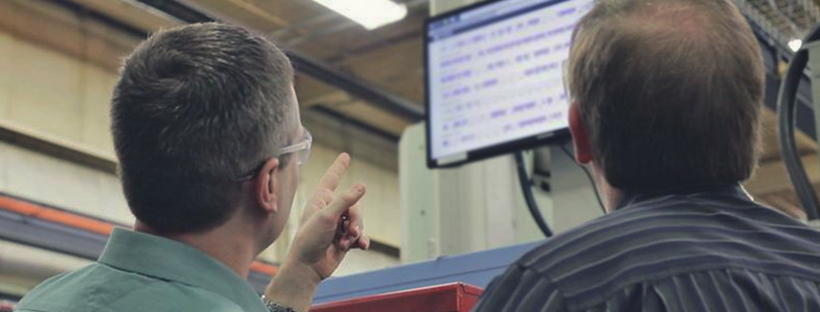
There are many ways to help your business achieve its full potential. But you have to know where to look, and how. If your factory floor is full of old, analogue machinery, then chances are you don’t have real-time insights into your working efficiencies. You might think that your old machines are probably incompatible with state-of-the-art IIoT systems. You’re probably wrong.
Certain machine monitoring systems (like FreePoint Technologies) are compatible with legacy machinery. It might not cost you as much as you think to gain real-time Overall Equipment Efficiency (OEE) data that provides unprecedented access to the productivity of your entire factory floor.
There are five areas to consider when identifying whether your business is in need of higher efficiency. We’re going to explore the five red flags to determine whether you can afford not to invest in machine monitoring.
1. Lack of information
If your factory is powered by disparate machinery, there’s no accurate way of knowing whether your machines are working at optimum speed, whether they require maintenance, or whether one device is creating a bottleneck of jobs for the other tools in the line.
Machine monitoring solutions provide the management team and the factory-floor worker alike with real-time insights regarding the OEE of your machinery.
Data is meaningless without a central hub that pits efficiencies against the overall mechanism. Machine monitoring interfaces are available on the factory floor. But also through smart technologies such as internet-enabled smartphones, tablets, and laptops.
Also, real-time productivity data illustrates an accurate expression of efficiencies, allowing you to identify areas where your production is failing and areas where you’re overproducing.
There’s also the chance that your customers might need an accurate price quotation. Without machine monitoring, your quote is likely to be a lucky guess.
Hence, more and more, customers expect OEE tracking so that they know for sure that the products you’re producing are going to arrive on time, as well as on budget. Savvy customers recognize that companies who adopt IIoT technologies are more likely to deliver their jobs on time.
Know More About Machine Integration. Register for Exclusive Microsoft Canada Event.
2. Machine operators aren’t engaged
One of the problems with being “a cog in the wheel” is that you don’t always appreciate your real contribution to the overall process. A worker who operates a single machine may become blinkered and despondent about the whole process. It’s difficult to see how your task affects the entire production process.
Machine monitoring provides real-time information regarding an individual’s productivity. Through this, they can see how their role contributes to the overall product. There are lots of ways to engage employees, and machine monitoring provides an excellent opportunity to introduce gamification into the workplace. Employees can judge their productivity against the norms of their peers. You can incentivize them to produce great work with greater efficiencies. And, therefore, you put your employee in control of their productivity.
3. Unclear uptime / downtime
You can’t manage what you don’t measure. You may have heard that before. It’s completely true. Lean manufacturing is all about managing your workflow to coincide with customer orders and recognising when and where maintenance is required.
Many businesses over-maintain their equipment, leading to a loss in production time; or conversely, their equipment may be under-maintained which can lead to an unplanned outage. Losing a single machine can lead to delays in delivery and impact upon your customer, while under-maintenance leads to unnecessary wear-and-tear on your devices.
Furthermore, a real-time OEE system allows you to transform your shop floor into a laboratory of data, providing specific milestones that facilitate informed, clear targets and the tracking of individual and team performances.
4. Losing money
If your business isn’t as efficient as it could be, the outcome is that you’re losing money. If you’re missing the money, then your staff suffer because your profitability suffers. Increasing profitability benefits the entire workforce, and it doesn’t necessarily mean that people have to work harder; they work smarter.
5. Failing production line
Machine monitoring provides a real-time indication of functions that are failing the overall production line. Consequently, you can increase your bottom-line profitability by obtaining a precise image of every single process on your shop floor; offering you unprecedented insight into where efficiencies can be made. Capable of identifying minute inefficiencies in a machine’s operation and you can save time from each process while creating better products; controlled by central hubs that provide oversight of your entire functionality.
And because machine monitoring embraces the IIoT, you can access your productivity information from the other side of the planet if you need to – through your smartphone or laptop.
Equipping yourself with data allows you to increase productivity. And hence rising productivity enables you to affect your profit margins positively and everyone benefits from that: you, your staff and, ultimately, your customers.
Microsoft Exclusive Event

On May 17th, Microsoft and FreePoint Technologies with other partners, are showing the Best Apps Microsoft Dynamics Manufacturing Apps to optimise your business:
- Human Resources
- Cad integration
- Machine integration
- Managed Security
- Payroll
- EDI
- Advanced Billing
- Lease
- Funding
- Warehouse management
- Field service
- Lean
If your company is looking for a new manufacturing software or to upgrade from a legacy version of Microsoft, this event will provide you with the answers you need to make an informed decision.
Join us at Microsoft Canada. CLICK HERE to register.
